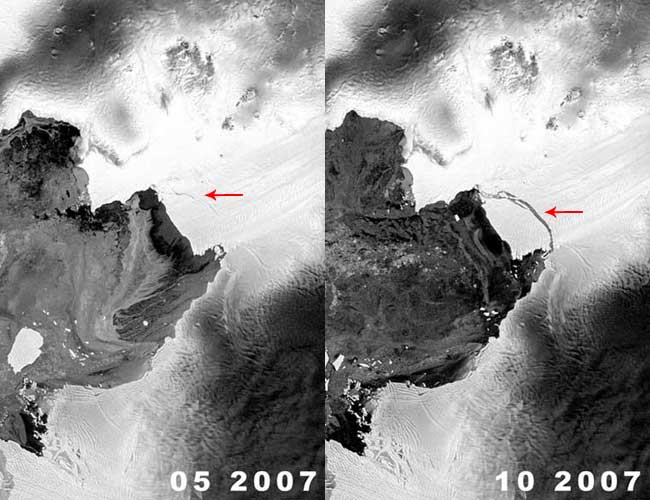Birth of Antarctic Iceberg Imaged from Space

Satellite images taken over the last year show the birth of an iceberg as it broke away from its parent glacier in Antarctica and drifted out to sea.
The newborn iceberg, which measured 21 by 12 miles (34 by 20 kilometers), was spotted breaking away from the Pine Island Glacier in West Antarctica by scientists in images taken by the European Space Agency's Envisat satellite between September 2006 and October 2007.
The process of iceberg formation, called calving, can be caused by wave or wind action, collision with a larger iceberg, or an ice shelf growing too large to support itself at the point where it meets the sea.
The calving of large icebergs such as this one is a natural part of the life cycle of the West Antarctic Ice Sheet (WAIS); a 34-year-long study showed that one of the icebergs breaks off every 5 to 10 years. The last such major iceberg calved away in 2001.
The Pine Island Glacier is the largest in the WAIS and transports ice from the deep interior of the ice sheet out to see. The glacier is up to 8200 feet (2500 meters) thick and comprises about 10 percent of the WAIS.
Observations have shown that the flow rate of the glacier out to sea has accelerated over the past 15 years, and a study by scientists at the British Antarctic Survey and University College London showed a loss of 7.5 cubic miles (31 cubic kilometers) of ice from the interior of the WAIS between 1992 and 2001, mostly from the Pine Island Glacier.
This thinning caused the glacier to retreat 3 miles (5 kilometers) inland—further evidence that small changes on the Antarctic coast, such as the effects of global warming, can be rapidly transmitted inland and lead to accelerating sea level rise through ice melt.
Get the world’s most fascinating discoveries delivered straight to your inbox.
This particular calving event, however, was not a significant change to the WAIS.
- Video: Under Antarctic Ice
- North vs. South Poles: 10 Wild Differences
- Images: Ice of the Antarctic

Andrea Thompson is an associate editor at Scientific American, where she covers sustainability, energy and the environment. Prior to that, she was a senior writer covering climate science at Climate Central and a reporter and editor at Live Science, where she primarily covered Earth science and the environment. She holds a graduate degree in science health and environmental reporting from New York University, as well as a bachelor of science and and masters of science in atmospheric chemistry from the Georgia Institute of Technology.


